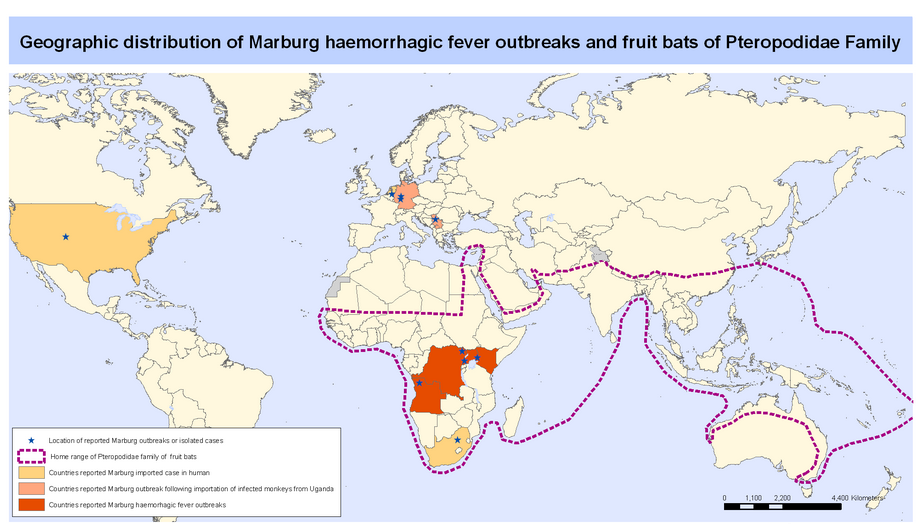Marburg hemorrhagic fever epidemiology and demographics: Difference between revisions
m (Changes made per Mahshid's request) |
Tarek Nafee (talk | contribs) No edit summary |
||
| Line 1: | Line 1: | ||
__NOTOC__ | __NOTOC__ | ||
{{Marburg hemorrhagic fever}} | {{Marburg hemorrhagic fever}} | ||
{{CMG}}{{AE}} | |||
==Overview== | |||
Both Marburg and [[Ebola]] hemorrhagic fevers are rare and have the capacity to cause dramatic outbreaks with high fatality rates. | Both Marburg and [[Ebola]] hemorrhagic fevers are rare and have the capacity to cause dramatic outbreaks with high fatality rates. | ||
| Line 6: | Line 8: | ||
Two large outbreaks that occurred simultaneously in Marburg and Frankfurt in Germany, and in Belgrade, Serbia, in 1967, led to the initial recognition of the disease. The outbreak was associated with laboratory work using African green monkeys (Cercopithecus aethiops) imported from Uganda. Subsequently, outbreaks and sporadic cases have been reported in Angola, Democratic Republic of the Congo, Kenya, South Africa (in a person with recent travel history to Zimbabwe) and Uganda. In 2008, two independent cases were reported in travelers who visited a cave inhabited by Rousettus bat colonies in Uganda. In 2014, one fatal case of Marburg virus was reported in Uganda with subsequent quarantine of 99 individuals. | Two large outbreaks that occurred simultaneously in Marburg and Frankfurt in Germany, and in Belgrade, Serbia, in 1967, led to the initial recognition of the disease. The outbreak was associated with laboratory work using African green monkeys (Cercopithecus aethiops) imported from Uganda. Subsequently, outbreaks and sporadic cases have been reported in Angola, Democratic Republic of the Congo, Kenya, South Africa (in a person with recent travel history to Zimbabwe) and Uganda. In 2008, two independent cases were reported in travelers who visited a cave inhabited by Rousettus bat colonies in Uganda. In 2014, one fatal case of Marburg virus was reported in Uganda with subsequent quarantine of 99 individuals. | ||
[[File:Geographic distribution of MHF.png |thumb|center|500px| <SMALL><SMALL> ''[(http://www.who.int/csr/disease/marburg/GlobalMarburgOutbreakRisk_20090510.png?ua=1)]''<ref name="CDC">{{Cite web | title = World Health Organization | url =http://www.who.int/csr/disease/marburg/GlobalMarburgOutbreakRisk_20090510.png?ua=1 }}</ref></SMALL></SMALL>]] | [[File:Geographic distribution of MHF.png |thumb|center|500px| <SMALL><SMALL> ''[(http://www.who.int/csr/disease/marburg/GlobalMarburgOutbreakRisk_20090510.png?ua=1)]''<ref name="CDC">{{Cite web | title = World Health Organization | url =http://www.who.int/csr/disease/marburg/GlobalMarburgOutbreakRisk_20090510.png?ua=1 }}</ref></SMALL></SMALL>]] | ||
==Epidemiology and Demographics== | |||
==References== | ==References== | ||
Revision as of 13:52, 19 October 2017
|
Marburg hemorrhagic fever Microchapters |
|
Differentiating Marburg hemorrhagic fever from other Diseases |
|---|
|
Diagnosis |
|
Treatment |
|
Case Studies |
|
Marburg hemorrhagic fever epidemiology and demographics On the Web |
|
American Roentgen Ray Society Images of Marburg hemorrhagic fever epidemiology and demographics |
|
FDA on Marburg hemorrhagic fever epidemiology and demographics |
|
CDC on Marburg hemorrhagic fever epidemiology and demographics |
|
Marburg hemorrhagic fever epidemiology and demographics in the news |
|
Blogs on Marburg hemorrhagic fever epidemiology and demographics |
|
Risk calculators and risk factors for Marburg hemorrhagic fever epidemiology and demographics |
Editor-In-Chief: C. Michael Gibson, M.S., M.D. [1]Associate Editor(s)-in-Chief:
Overview
Both Marburg and Ebola hemorrhagic fevers are rare and have the capacity to cause dramatic outbreaks with high fatality rates.
Two large outbreaks that occurred simultaneously in Marburg and Frankfurt in Germany, and in Belgrade, Serbia, in 1967, led to the initial recognition of the disease. The outbreak was associated with laboratory work using African green monkeys (Cercopithecus aethiops) imported from Uganda. Subsequently, outbreaks and sporadic cases have been reported in Angola, Democratic Republic of the Congo, Kenya, South Africa (in a person with recent travel history to Zimbabwe) and Uganda. In 2008, two independent cases were reported in travelers who visited a cave inhabited by Rousettus bat colonies in Uganda. In 2014, one fatal case of Marburg virus was reported in Uganda with subsequent quarantine of 99 individuals.
